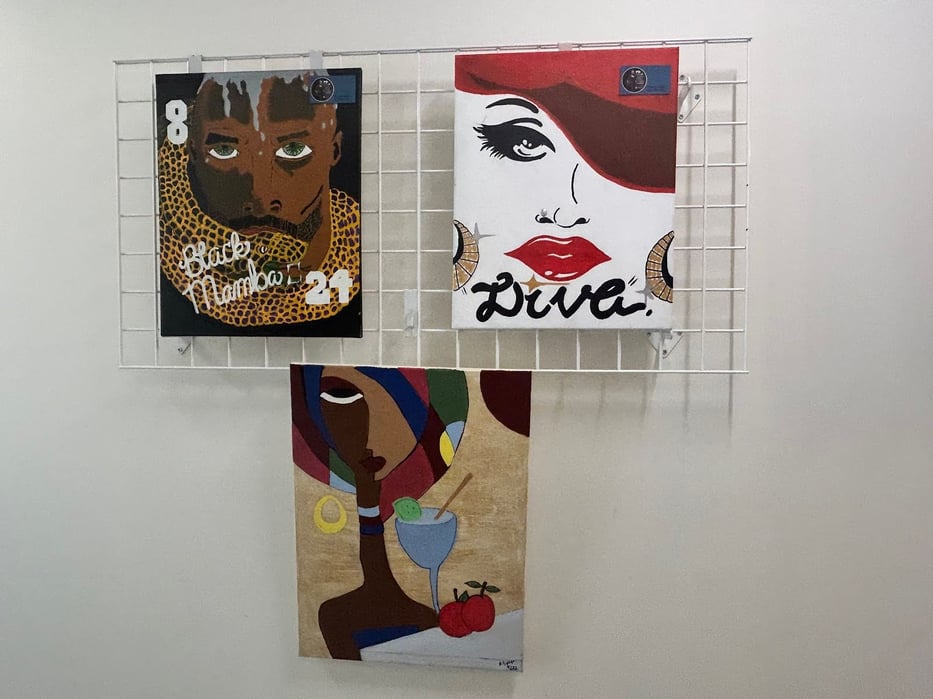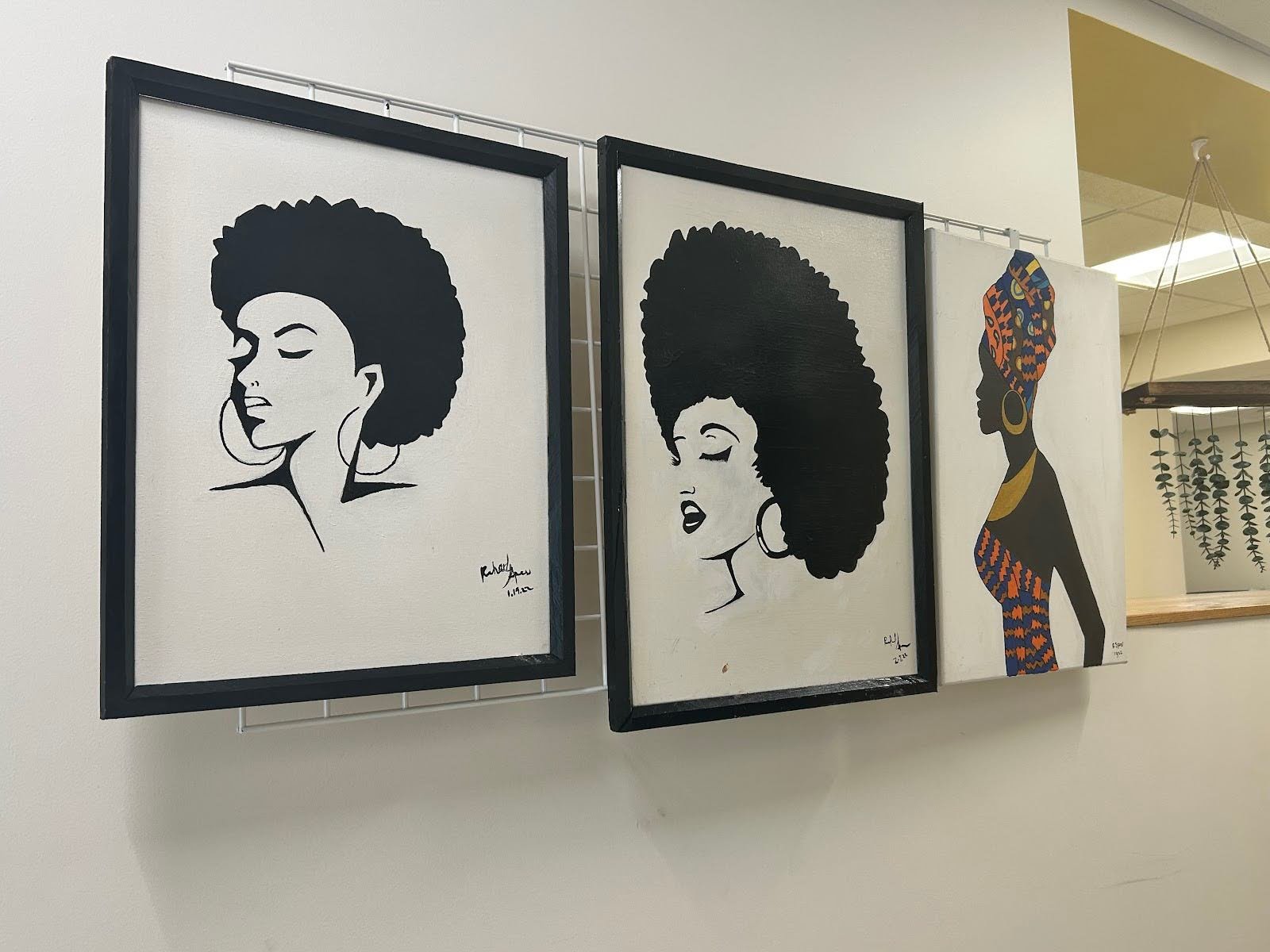 In the midst of barren landscape, a stretch of long, winding road disappears into the horizon and sunset, engulfed in a bursting sun. Where it leads, no one knows: it is surrounded by red, muddy earth, the ground cracked and uneven. As color stretches across the canvas, a viewer’s eye gravitates towards the middle, where a roaring, red ball of fire seems to stare right back.
In the midst of barren landscape, a stretch of long, winding road disappears into the horizon and sunset, engulfed in a bursting sun. Where it leads, no one knows: it is surrounded by red, muddy earth, the ground cracked and uneven. As color stretches across the canvas, a viewer’s eye gravitates towards the middle, where a roaring, red ball of fire seems to stare right back.
That painting, by artist and curator Victor Smith, is part of the Elm City Art Group’s latest show, running at the Ora Mason Branch Library in West Haven through Sept. 12. A collaboration with the arts-focused advocacy group ArtsWestCT, it features work by Smith, as well as artists Paris Huling and Richard Spears.
The library, located at 260 Benham Hill Rd. in West Haven, is open Monday through Friday. Hours and more information are available here. In an interview for this story, Smith credited ArtsWest CT President Elinor Slomba, creator of Verge Arts Group, with creating vast cultural connections in the city that enabled such a show.
Smith, born and raised in Jamaica, began drawing at seven years old. He started entering national competitions when he was 17 years old. When he was 18, however, he started to experience what he referred to as “setbacks” in life.
“I had some very distressing disappointments and I decided to paint them,” he said. “And as a result, my work started to be noticed.”
He won his first award, one of two that would eventually come, at 21 years old. Newspapers picked up what he was doing; he had some local coverage on the radio and television.
He was glad that his art was getting noticed, he said. At the time—as viewers can still see in his work today—he expressed his emotions through surrealist painting.
He moved to New Haven in 1974 and started exhibiting at a small gallery space at the Arts Council of Greater New Haven, which at the time had a gallery space in its 70 Audubon St. offices. By 1984, he had opened Kaleidos Arts Group, which held several exhibitions in New Haven before it disbanded. Members broke into two factions, male and female.
At the time, Smith remembered, he was so upset by the whole ordeal that he stopped painting distanced himself from both groups. But his paints and canvases ultimately called him back: the Elm City Arts Group rose from its ashes.
Smith usually does semi- or fully realistic pieces, he said. In the Ora Mason show, however, he wanted to feature his most recent experiments with color. In the show, red, oranges, and yellows fill the walls, a reflection of a positive period of his life that he’s currently in.
“I paint if I’m in a good mood, I use bright colors,” he said. “If I’m not in a good mood, I use the blues and the gray and the purples.”

Across the room hang Huling’s pieces, which are much less abstract, and more interested in the human figure. Huling met Smith through a friend at work and the two have continued to keep in touch and collaborate since, he said.
“I guess his brother was telling him about me and I like to draw,” Huling said. Initially, the two planned a group show last year, but it was ultimately cancelled. This time around, Smith made sure to give Huling enough time to put a couple pieces together.
The pieces reflect decades of evolution as an artist. Huling started drawing at around five years old, taught by his aunt. But his interest in art really started to develop in the third grade, after a teacher salvaged a piece of art from the trash and urged him not to give up on the design.
“She told me, ‘You didn’t even complete this,’” Huling recalled. “She said, ‘You could do a lot of things to make it complete.’ So from that point forward, I just started paying attention.”
After that, he began to put effort and practice into his craft, saving his previous work as a reference point to look back on (to this day, he said, looking at his prior work is a form of motivation). He began to challenge himself and try to do things that others hadn’t seen or done before.
One of his favorite pieces in the Ora Mason exhibition is Black Mamba, an homage to the late NBA player Kobe Bryant. The piece shows Bryant around retirement age, with a yellow and black snake wrapped around his neck. Amidst the dark colors, the yellow snake and the dark green of Bryant’s eyes stand out. Painted by the corners of the canvas are the numbers eight and 24, both of which Bryant sported on his jersey during his career.
Below his face, “Black Mamba” is written in white cursive text, a nod to the nickname Bryant carried for years.
Huling has been a longtime basketball fan, a love that started with the 1979 championship game between Michigan State and Indiana State Universities. He drifted away from basketball before hearing about Bryant, and then started to watch again.
“He was young, he wasn’t afraid of anyone,” Huling said, describing the player in his earlier years.
“It was a tragedy the way he passed and I’ve been a Kobe Bryant fan ever since he’s been in the league and he’s one of my favorite players of all time,” he said. “So I seen a picture and was like, ‘Lemme see if I could do this.’”

Spears’ contribution to the exhibition, meanwhile, features portraits of Black women from the waist or neck up, sometimes in profile. Most of them are rendered in black and white; some have their eyes closed. One that is especially striking shows a woman, her head regally wrapped, dressed in African wax print and gold jewelry.
Smith said that the exhibition ties back to Elm City Arts Group’s main purpose: to give artists a platform to show their work, and create more spaces to both show and see visual art in greater New Haven. He recently retired from his job at Yale-New Haven Hospital, which opened up his schedule even more.
“My greatest desire now is to help young up-and-coming artists to get their work exhibited," he said. “I made my money, I’ve got my fame, I’ve got everything that I wanted. But my greatest desire now is to help as many younger ones to get into the limelight.”
This exhibit is not Smith’s last of the year; he will be hosting exhibits at the main West Haven Library in September and October as well.
This article comes from the 2025 cohort of the Youth Arts Journalism Initiative (YAJI). YAJI is a program in which New Haven, Hamden and West Haven Public Schools high school students pitch, write, edit and publish articles through the Arts Paper. This year, YAJI advisors include Arts Paper Editor Lucy Gellman and reporter and YAJI alum Abiba Biao. Keira Anderson is a rising senior at Cooperative Arts & Humanities High School, where she studies creative writing.